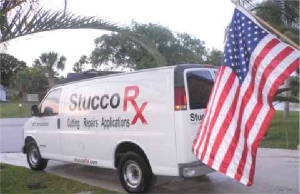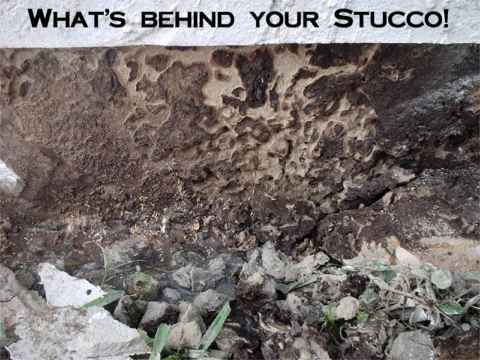| Stucco Cutters |

|
Stucco Cutting by Stucco RX Inc Orlando / 407-470-2529
Daytona 386-864-9569

|
| Stucco Cutting prevents moisture permeation. |
EXPOSED!
Stucco Cut reveals Termites secretly
tunneling behind Stucco and into the House!
| After Stucco Cut |
|
|
| STUCCO CUT,SEALED AND PAINTED. |
| TERMITE "SUPER HIGHWAY " HIDDEN,BEHIND THE STUCCO |
|
|
UF TERMITE EXPERT: NEW BUILDING CODE WILL HELP STOP PEST
Feb. 15, 2002
Contact Information | IFAS Photo Page
 GAINESVILLE, Fla. --- With termite damage at record levels, a University of Florida pest control expert says a new statewide
building code will help stop the tiny home wreckers.
GAINESVILLE, Fla. --- With termite damage at record levels, a University of Florida pest control expert says a new statewide
building code will help stop the tiny home wreckers.
"Termite damage and control
costs in Florida exceed $500 million annually, but that will be reduced by the new Florida Building Code, making builders
more responsible for termite protection," said Phil Koehler, professor of entomology with UF's Institute of Food
and Agricultural Sciences. The code becomes effective March 1.
Koehler said the record
number of termite treatment failures in Florida is occurring because there has been no standard control method required on
new homes.
"Florida counties usually require some kind of termite protection
on new structures, but the methods vary from county to county. The result has been a hodgepodge of codes that leave many consumers
unprotected and confused," he said.
He said most current building codes do not
require building contractors or pest control operators to prevent termite infestations.
"As
a result, the pest control industry refuses to pay for repairs when building contractors either disrupt their treatments,
build hidden termite access into buildings or provide moisture that allows termites to survive in buildings," he said.
"These problems usually don't show up until the damage is done. Pest control industry warranties will not cover houses
that provide termites with conditions that allow them to thrive."
Koehler, who
chaired a committee of architects, builders, building code officials, pest control operators and pesticide manufacturers that
recommended code changes, said the new code is long overdue in Florida.
"When
it comes to stopping termites, including the highly destructive Formosan termite now spreading throughout Florida and the
U.S. Southeast, we need a standardized statewide code to protect homeowners from termites," he said.
The St. Johns County, Fla., building code served as a model for the new state code, he said.
"The county's code prevents hidden termite access into buildings through voids behind exterior
finishes that extend to the ground, such as stucco and masonry," Koehler said. "It increases the effectiveness of
chemical barrier treatments under foundations by requiring down spouts from rain gutters to discharge water away from buildings.
And it eliminates termite food sources in contact with the ground such as building debris, form boards and grade stakes."
While chemical barrier treatments under and around the foundation are effective, they deteriorate over
time and must be reapplied about every five years. As an alternative, Koehler recommends builders use borate-treated wood
throughout the house. Under the new code, the sill plate in contact with the concrete slab is the only wood that must be treated.
Lumber pressure-treated with chromated copper arsenate, or CCA, is the most widely used material, but
it's being phased out because arsenic is a known carcinogen. He said effective alternative treatments include zinc borate
or sodium borate. And while borate-treated wood costs more than untreated wood, the long-term benefits make it cost-effective
for homeowners.
"For example, if the cost of using untreated wood in a typical
2,000-square-foot house is about $9,000, the cost of using borate-treated wood would be about $12,000 -- a $3,000 increase,"
he said. "However, the estimated $800 cost of chemical soil treatments every five years -- plus the annual $100 renewal
fees most pest control operators charge -- totals $4,800 over 20 years. During the same period, the treated wood option saves
$1,800."
Koehler said new home buyers may be lulled into a false sense of security
by builders who use unproven termite control measures, such as spraying untreated wall studs with borates. The growing practice
of coating wall studs with borate to a height of about 24 inches has not been proven to prevent termite damage. Termites have
the ability to enter at the bottom of the stud and tunnel up through the center of the 2-by-4-inch wall supports.
"It's just another example of the many things being promoted to reduce the initial cost of
termite treatment, leaving the home buyer with the risk of termite infestation and high out-of-pocket costs to retreat and
repair damage" Koehler said.
-30-
By
Chuck Woods
Source: Phil Koehler (352) 392-2484 pgk@gnv.ifas.ufl.edu
Top of Release | Return to Top of Archived Releases | Daily News & Events | Search UF | UF Home Page
| Hidden Termite mud tube behind Stucco |
|
|
Florida
Enter subhead content here
